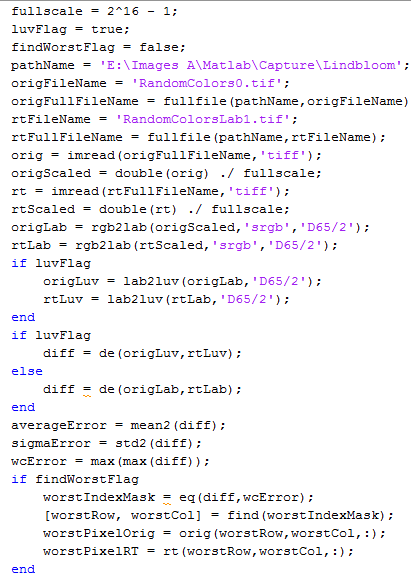It occurred to me that, what with CIEL*a*b* being the reference standard for the ICC color management scheme, that there might be some bias towards minimizing errors measured in Lab built into the Photoshop/ACE algorithms. Lab is not perceptually uniform, although it tries hard, so things might be worse than they seem when Lab DeltaE is the criterion.
Fortunately, there is another color space with a different algorithm that has the same aspirations as Lab; that’s CIEL*u*v*. Lab and Luv share the definition of the luminance axis, but the two chromaticity components are calculated quite differently. Traditionally, Lab has been used in the print industry, while Luv holds sway in the world of emissive displays.
I re-ran yesterday’s tests with our 256 megapixel uniformly distributed random colors image to compute errors in Luv DeltaE. As is usual in a code-while-you-learn project like this, the program is growing:
The results?
From sRGB to Adobe (1998) RGB and back:
- average error of 0.0020 CIELab DeltaE
- average error of 0.0020 CIELuv DeltaE
- standard deviation of 0.0049 CIELab DeltaE
- standard deviation of 0.0035 CIELuvDeltaE
- worst-case error of 0.2121 CIELab DeltaE
- worst-case error of 0.1713 CIELuv DeltaE
This is not as good as we got doing the conversions in Matlab, but it is good enough that photographer should have to worry about damaging their images by making this set of color space conversions.
From sRGB to ProPhotoRGB and back:
- average error of 0.0030 CIELab DeltaE
- average error of 0.0034 CIELuv DeltaE
- standard deviation of 0.0026 CIELab DeltaE
- standard deviation of 0.0030 CIELuvDeltaE
- worst-case error of 0.0900 CIELab DeltaE
- worst-case error of 0.0605 CIELuv DeltaE
From sRGB to Lab and back:
- average error of 0.0040 CIELab DeltaE
- average error of 0.0047 CIELuv DeltaE
- standard deviation of 0.0033 CIELab DeltaE
- standard deviation of 0.0028 CIELuvDeltaE
- worst-case error of 0.0875 CIELab DeltaE
- worst-case error of 0.0556 CIELuv DeltaE
The Luv results are not materially different from the Lab ones.

Leave a Reply